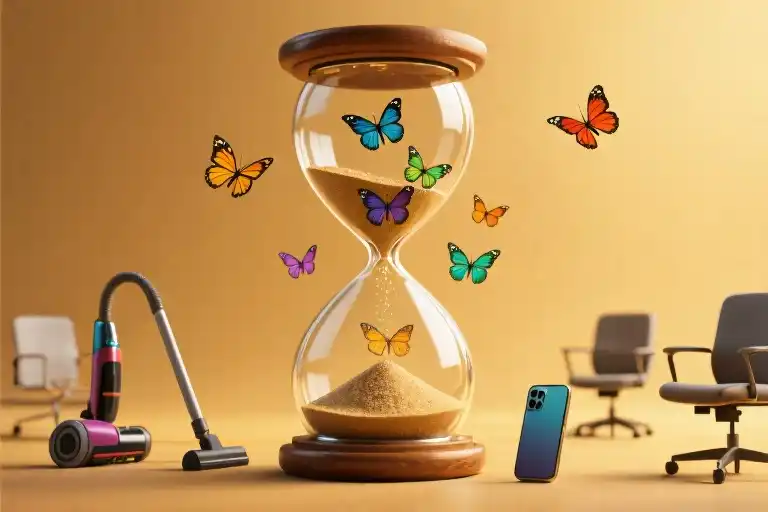I didn’t want to write this. The admission feels important, like when you catch yourself sighing for the third time before checking your phone again. There’s something revealing about our resistance to the things that might actually help us.
It came to me in the fluorescent glow of the grocery store, watching a woman in a faded denim jacket argue about expired coupons. Same store. Same cashier. Same hollow victory when the manager finally gave her the discount just to end the scene. I’d witnessed this ritual three Thursdays in a row – her voice climbing the same octaves, fingers tapping the same rhythm on the conveyor belt.
Some of us are stuck in loops so tight we mistake the walls for comfort. The cashier’s eyes held that exhausted recognition people get when they’ve memorized someone else’s script. We call these habits, routines, coping mechanisms – soft words that disguise how often we’re replaying the same moment with different lighting.
This isn’t about grocery store dramas. It’s about the emails we rewrite five times before sending, the workouts we cancel with identical excuses, the conversations where we mouth old lines like actors in a play we never auditioned for. Modern life gives us endless choices yet we keep choosing familiar discomfort over uncertain change.
Neuroscientists call it the ‘status quo bias’ – our brain’s preference for known miseries over unknown possibilities. Ancient Greeks had a sharper term: akrasia. That gap between knowing and doing that philosophers have been tripping over for millennia. There’s something comforting in realizing even Aristotle struggled with this; that toga-clad thinkers would procrastinate just like us, probably while staring at olive trees instead of Instagram.
What makes these loops so sticky isn’t weakness or lack of willpower – it’s biology. Your brain is like a Victorian engineer, obsessed with conserving energy. Every routine, no matter how unhelpful, gets paved into neural pathways like cobblestone streets. The more you travel them, the smoother they become until detours feel like trespassing.
That woman at the store? She wasn’t just fighting for 50 cents off cereal. She was following pathways worn deep by repetition, where the script provides comfort even when the ending stings. We all have versions of this – automatic behaviors so ingrained we forget we’re the ones who kept practicing them.
Here’s what the ancient thinkers missed: these loops aren’t failures of character, but of design. Your brain didn’t evolve for happiness or growth – it evolved for survival. In a world of scarcity, predictability trumped fulfillment. We inherited machinery optimized for repetition, now stuck in a world that rewards flexibility.
Next time you catch yourself in one of these loops – reaching for your phone during a lull, reheating old arguments, postponing that thing again – pause just long enough to notice the walls. They might feel like home, but they’re really just well-worn paths. And paths, no matter how deep, can always grow grass when we stop walking them.
The Grocery Store Epiphany
That woman in the checkout line wasn’t just arguing about coupons. She was performing a ritual we all know too well – the dance of repeating what doesn’t work. I’ve counted at least three Thursdays now where I’ve watched this same scene unfold: same faded denim jacket, same exasperated sigh from the cashier, same crumpled coupons pulled from that oversized beige purse. The details never change, only the dates on those expired slips of paper.
We mistake these loops for personality traits. ‘Oh that’s just Karen being Karen,’ we might say about our office colleague who always complains about meetings but never suggests alternatives. Or ‘typical me’ when we reach for the phone first thing in the morning, scrolling through the same apps in the same order, despite swearing yesterday we’d stop. These aren’t quirks – they’re cognitive autopilot programs running on repeat.
University of London researchers found the average person checks their phone 221 times daily. But here’s what their 2018 study really revealed: 87% of those unlocks follow identical patterns. Same thumb swipe, same apps in same sequence, same hollow feeling afterward. We’re not making 221 decisions – we’re replaying one decision 221 times.
My kitchen tells the same story. That cabinet above the coffee maker holds three identical half-empty bags of whole bean coffee, bought weeks apart. Each time I swore ‘this is the one that’ll get me grinding fresh beans every morning.’ Yet there they sit, alongside my abandoned French press and that pour-over set still in its box. The evidence of abandoned better intentions piles up like archaeological layers.
These loops share DNA. Whether it’s the gym membership we keep paying for but never use, the emails we mark as unread to deal with ‘later,’ or the way we always order pad thai from the same takeout place despite wanting to try something new – they’re all variations on the theme of knowing better but doing otherwise. The ancient Greeks called it akrasia. We might call it being human.
What makes these patterns so stubborn isn’t their complexity, but their simplicity. Like grooves worn deep in a dirt road, the more we travel them, the harder they become to avoid. Our brains love these well-worn paths precisely because they require no thinking. Every rerun of our personal Groundhog Day saves us the cognitive calories of making actual choices.
Yet somewhere between the third coffee bag and the fiftieth mindless phone unlock, we start sensing the walls of our self-made maze. The frustration builds not from being trapped, but from seeing the trap clearly while still walking into it. That’s the peculiar pain of modern self-awareness – knowing the script by heart yet still reciting our lines perfectly.
Your Brain’s Energy Crisis
That woman at the grocery store wasn’t just stubborn—her brain was literally fighting against change. We all have these moments where we know exactly what we should do, yet find ourselves repeating the same unhelpful patterns. The secret lies in understanding how our brains are wired for energy conservation, not efficiency.
Neuroscientists have mapped out what happens in our heads when we operate on autopilot. The basal ganglia, a set of structures deep in your brain, form the habit control center. When you perform routine actions—whether arguing with cashiers or mindlessly scrolling your phone—this region lights up like a Christmas tree on fMRI scans. It’s running the well-worn programs that require minimal cognitive effort.
A revealing 2016 MIT study compared brain activity during new tasks versus established routines. Novel activities triggered widespread neural fireworks across the prefrontal cortex—the energy-intensive CEO of your brain. But habitual behaviors showed localized, efficient activation patterns that used about 60% less metabolic resources. Your brain isn’t lazy; it’s just following evolutionary programming that values energy conservation above all else.
This explains why change feels so exhausting. Every attempt to break a habit requires your prefrontal cortex to override the basal ganglia’s automatic settings. It’s like trying to manually breathe while also remembering to blink—possible, but draining. The cognitive load of constant decision-making explains why most New Year’s resolutions fail by February. Our brains simply can’t sustain that level of energy expenditure long-term.
Yet this apparent design flaw served our ancestors well. Early humans couldn’t afford to deliberate over every action when predators lurked nearby. Automatic responses meant survival. Today, without saber-toothed tigers chasing us, these same mechanisms trap us in less helpful loops—from snacking when stressed to replaying old arguments in our heads.
The paradox? These energy-saving circuits actually consume more resources in the long run. Like a phone stuck in battery-saver mode, we sacrifice performance for endurance. Understanding this tradeoff helps explain the akrasia effect—why we knowingly make choices that undermine our wellbeing. It’s not weakness; it’s your brain’s misguided attempt to protect you from cognitive overload.
Next time you find yourself stuck in a behavior loop, remember: you’re not fighting laziness, but millions of years of evolutionary programming. The good news? Awareness alone begins rewiring those patterns. Simply noticing when your basal ganglia takes the wheel creates space for your prefrontal cortex to step in. No willpower required—just the gentle redirection of attention to where it serves you best.
The Grocer’s Third Act
She was back again. Same faded denim jacket, same determined set to her jaw as she slapped those coupons on the conveyor belt. From my place three customers behind, I could already predict the script: the cashier’s polite refusal, the escalating tone, the eventual retreat with groceries but without victory. This marked the third Thursday I’d witnessed this ritual at my neighborhood Kroger.
We all have these loops – not just the coupon woman, but you scrolling through your phone past midnight again, me rewriting the same paragraph for the fourth time. The ancient Greeks called it akrasia, that peculiar human talent for acting against our own best interests. Socrates found the concept baffling – how could rational beings knowingly choose harm? His solution was characteristically blunt: if you’re doing the wrong thing, you must not truly understand what’s right.
Modern neuroscience paints a messier picture. That grocery store stalemate isn’t (just) about stubbornness or lack of willpower. Our basal ganglia – the brain’s autopilot center – creates neural highways for repeated behaviors. Like ruts in a dirt road, these pathways become deeper and harder to escape with each pass. The coupon confrontation wasn’t merely habit; it was my neighbor’s brain conserving cognitive energy by reenacting a familiar drama rather than drafting a new script.
Aristotle took a more nuanced view than Socrates, identifying distinct flavors of akrasia. There’s the impulsive variety (grabbing that third cocktail), the weak-willed type (vowing to quit smoking tomorrow), and what he called ‘impetuous akrasia’ – the coupon woman’s special blend of principle and pettiness. Two millennia later, a Harvard study timed how long it takes for reason to engage when habits are challenged: about 0.3 seconds too late to stop most automatic reactions.
What fascinates me isn’t that we fall into these loops, but how fiercely we defend them. That woman wasn’t just arguing with the cashier – she was debating with her own better judgment in real time. We’ve all been there: halfway through a fast food binge knowing we’ll regret it, hitting snooze despite important meetings, refreshing social media while complaining about wasted hours. The coupons were just her visible manifestation of a universal struggle.
Perhaps the most humbling modern finding comes from behavioral economist Dan Ariely. His experiments suggest we’re worse at resisting temptation when tired, stressed, or – ironically – after exerting willpower. That explains why diet plans fail at parties, gym memberships lapse in winter, and yes, why certain customers keep fighting expired coupon battles they can’t win. Our best intentions crumble not from moral weakness, but from poor system design – both in our environments and our minds.
Next time you catch yourself in one of these loops, try this: instead of judging the behavior, get curious about its architecture. What triggers it? What reward (however small) maintains it? My grocery store philosopher might discover her coupon battles always follow stressful work calls, or that ‘winning’ the argument provides momentary relief from feelings of powerlessness. As psychologist Judson Brewer found, simply observing our habit loops with detached interest can begin rewiring them – no willpower required.
Socrates was wrong about one thing: understanding alone doesn’t change behavior. If it did, every smoker would quit after reading the warning label, and no one would speed knowing the risks. Real change requires something more vulnerable – admitting we’re not purely rational creatures, that our ancient brains often override our modern wisdom. Maybe that’s the true akrasia: not our failure to act on knowledge, but our refusal to acknowledge how little knowledge actually governs our actions.
The Willpower Trap
For decades, we’ve been sold a story about self-control that doesn’t quite add up. The famous marshmallow test—where children who resisted temptation supposedly went on to greater success—has been misinterpreted in ways that do real harm. Newer research shows that willpower alone accounts for less than 10% of behavior change success rates. The real determinants? Environment, routine, and what psychologists call ‘cue exposure.’
Consider this: the same person who can’t resist checking their phone during work hours might have no trouble fasting for religious observances. The difference isn’t personal discipline—it’s about the systems surrounding each behavior. Your brain isn’t a muscle that gets stronger with exercise; it’s more like a sophisticated pattern-recognition machine that takes the path of least resistance unless deliberately rerouted.
Environmental cues shape about 43% of our daily actions according to habit formation studies. That coffee shop you pass on your commute? Its mere presence increases your likelihood of buying a latte by 300%, regardless of how much willpower you think you have. We’ve been blaming personal failure for what are actually design flaws in our surroundings.
The system resistance framework explains why change feels so hard. When you try to alter one behavior, you’re not fighting a single habit—you’re up against an entire ecosystem of triggers, rewards, and established neural pathways. It’s like trying to paddle upstream while the current keeps pulling you back. This explains why so many New Year’s resolutions fail by February: we focus on the swimmer (willpower) instead of the current (system design).
Three myths keep us trapped in this cycle:
- The ‘character’ myth: Believing failure reflects moral weakness
- The ‘effort’ myth: Assuming harder tries produce better results
- The ‘clean slate’ myth: Expecting total transformation overnight
What actually works? Start by mapping your behavior loops. That woman in the grocery store might notice she always reaches for coupons when feeling stressed about money. The pattern isn’t about savings—it’s about emotional regulation. By identifying the real trigger (anxiety), she could experiment with alternative responses (deep breathing, checking her budget app). Small system tweaks beat massive willpower investments every time.
Your environment isn’t just background—it’s the invisible hand shaping nearly half your choices. The good news? Unlike willpower, your surroundings can be redesigned. That’s where real change begins.
The 5% Reset
That woman in the grocery store wasn’t just arguing about coupons – she was trapped in a behavioral script written by her basal ganglia. We all have these invisible scripts running in the background of our lives. The good news? You don’t need to rewrite the entire play. Sometimes changing just the opening stage direction is enough.
Here’s what neuroscience teaches us about breaking loops: behavior chains have weak spots. Like dominos, they’re most vulnerable at the start. The MIT habit lab found that modifying just the first 5% of a routine can derail the entire automatic sequence. This isn’t about willpower – it’s about strategic interference.
Let’s return to our supermarket philosopher. What if instead of reaching for her coupon folder (the usual first move), she paused to place her shopping basket on the conveyor first? This tiny insertion creates what psychologists call ‘pattern interrupt’ – a cognitive speed bump that gives the prefrontal cortex precious seconds to engage. Suddenly what was automatic becomes optional.
The change-amplification effect follows a J-curve. Minimal initial adjustments (that 5% reset) create disproportionate downstream effects because they target the habit’s loading mechanism. It’s why Alcoholics Anonymous suggests ‘just don’t pick up the first drink’ rather than demanding lifelong sobriety upfront.
Try this with your own stuck loops:
- Map your behavior chain (what always happens first?)
- Design a 5% deviation (change the opening move)
- Observe the cascade (does the script still run?)
Your brain will protest. That’s the cognitive equivalent of muscle soreness – a sign you’re stretching beyond your default settings. The woman with coupons might never change, but you’ve just gained access to your behavioral control panel.
Sometimes freedom isn’t about grand transformations, but noticing there’s an exit you hadn’t seen before. It was there all along – right after you put down the basket.
The Grocery Store Epiphany
That woman at the checkout line still visits me sometimes when I’m trying to fall asleep. Not because her coupon battle was particularly dramatic, but because it was so perfectly ordinary in its futility. The way she straightened her posture just slightly before launching into the same argument. The practiced cadence of her complaints. The cashier’s tired sigh that seemed to say, ‘Here we go again.’
We all have these loops. Maybe yours happens when you open your laptop intending to work, only to find yourself three hours deep in social media. Or when you promise yourself this will be the last late-night snack, standing in the glow of the refrigerator for the third time this week. These patterns are so familiar they feel like old sweaters – not particularly flattering, but too comfortable to take off.
Neuroscientists tell us about 40% of our daily actions are habitual. That’s nearly half our lives running on autopilot. When researchers at Duke University mapped these behavior patterns, they found most people follow the same morning routine within a 15-minute window every single day. The same route to work. The same coffee order. The same arguments with loved ones using nearly identical phrasing.
What’s fascinating isn’t that we repeat behaviors – that’s how brains conserve cognitive energy. The real mystery is why we keep repeating patterns that actively work against our own stated goals. The ancient Greeks called this akrasia, that peculiar gap between knowing and doing. Modern psychology might call it cognitive dissonance, but wrapping it in Latin doesn’t make it any less frustrating when you’re the one stuck in the loop.
There’s something almost artistic in how we construct these personal Groundhog Days. We develop entire rituals around our ineffective behaviors. The deep breath before checking the ex’s social media again. The elaborate justification for skipping the gym. The ceremonial postponement of important tasks until some mythical future version of ourselves will handle them.
Perhaps the most telling detail in my grocery store observation wasn’t the argument itself, but what happened afterward. As the woman walked away empty-handed (again), I saw her pause by the magazine rack and pick up the same tabloid she’d browsed during her previous visits. Some loops have nested loops.
This isn’t about willpower. That’s the first myth we need to dismantle. If sheer determination could break these cycles, the self-help industry wouldn’t be worth billions. The real issue lies deeper, in how our brains mistake repetition for safety, even when that repetition leads us straight into frustration.
Next time you catch yourself in one of these loops – maybe reaching for your phone during a lull in conversation, or putting off that important email – try this: pause just long enough to notice the machinery at work. Don’t judge it. Don’t try to fix it immediately. Just observe the gears turning. There’s power in that momentary awareness, like catching the stagehands moving props between scenes.
Because here’s the secret those ancient philosophers missed while debating akrasia in their togas: sometimes simply seeing the loop clearly is enough to begin changing it. Not always. Not instantly. But sometimes, in that moment when you recognize the pattern, you might find yourself doing something radical.
You might choose differently.





